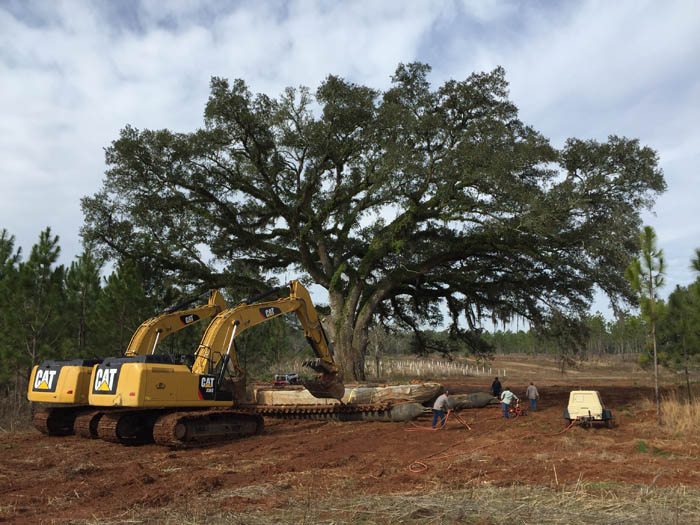If you want to know how to transplant a large tree, then you’re in the right place. Transplanting a large tree is a true art form that requires expertise, precision, and an informed understanding of all the practical aspects involved. It’s not just a matter of digging out the tree and re-planting it somewhere else—there are so many factors to consider.
There are several reasons why transplanting a large tree may be necessary. One common reason is when one desires to change its location, perhaps to enhance views or create more garden space. Safety is another consideration, particularly if the tree has been compromised by disease or storm damage, warranting relocation before it becomes a hazard. Furthermore, tree transplantation can improve the tree’s overall health. By moving it to an area with better soil conditions, the tree can thrive and reach its full potential. Lastly, aesthetic balance and harmony in landscape design can be achieved by relocating trees that are oversized for their current placement.
At Environmental Design, Inc. (EDI), we specialize in large tree relocation services. Our team has years of experience in all facets of environmental design, allowing us to provide the highest quality solutions for your individual needs. With 40 years of experience specializing in large tree transplantation, we present to you this ultimate guide on how to transplant a large tree successfully. From essential tips and tricks to the practicalities of moving these arboreal giants, we’ve got you covered every step of the way.
Why Tree Maturity Matters
Before we delve into the practical aspects, let’s touch upon the significance of tree maturity. Choosing the right tree for transplantation is crucial, and age and size play vital roles. We explore the recommended size and age of trees suitable for relocation, ensuring that your chosen tree is a perfect candidate for a seamless transplant.
Understanding the root system development of a tree is crucial, especially when it comes to transplantation. A well-developed root system is essential for the tree’s health and stability during and after the transplantation process. Mature trees with a strong root system have a higher likelihood of surviving and thriving in their new environment.
Transplanting trees with poorly developed root systems can be challenging. Their ability to adapt to the transplantation process may be limited, requiring additional care to promote successful establishment. The difficulty lies in ensuring that the fragile root system remains intact and is adequately nourished to support the tree’s growth in its new location.
Assessing the Site and Preparing for Transplantation
Preparing for a large tree transplant begins with a meticulous site assessment. The success of the transplant depends on the compatibility of the new location with the tree’s needs. We guide you through the critical factors to consider, including soil quality, drainage, sunlight exposure, and proximity to structures or utilities. Armed with this knowledge, you can ensure that your tree will thrive in its new environment.
In some cases, site preparation may involve improving the soil quality to provide the tree with the necessary nutrients and drainage. Additionally, examining the health of the tree before transplantation is vital. Trees with signs of diseases or pest infestations may require treatment before the transplant to prevent the spread of problems to the new location.
We also cover the essential steps for tree preparation, including root pruning and canopy reduction, reducing stress during the transplantation process. Proper root pruning encourages the growth of new, healthy roots that will anchor the tree in its new home. Canopy reduction, on the other hand, minimizes water loss and shock, allowing the tree to better adjust to its new environment.
Tools and Machinery
Now, let’s dive into the practical aspects of moving a large tree. Central to the process are the tools and machinery used for efficient and safe transplantation. Our experts rely on a range of specialized equipment, including shovels, spades, ropes, burlap, and tree wraps, to ensure smooth handling and protection during relocation.
For larger specimens, heavy machinery comes into play, making the process manageable and secure. Cranes and loaders are used to lift and transport the tree safely to its new location. Advanced machinery is especially critical when dealing with towering trees with massive root balls, as it reduces the risk of damage to the tree and surrounding landscape during the relocation.
Choosing the right equipment is crucial for the success of a transplant, especially when it comes to larger trees. The size of the tree, the type of soil, and the terrain of the site all play a significant role in determining the appropriate machinery. It’s important to note that most large tree transplants require specialized equipment that should be handled by experienced professionals. Our team of experts carefully assesses the requirements of each project to ensure the right tools are selected, guaranteeing a successful and efficient process.
Choosing the Right Season for Transplantation: Timing is Everything
Timing is crucial when it comes to transplanting large trees. Different seasons present unique challenges and opportunities for successful relocation. We explore the advantages and disadvantages of transplanting in spring, fall, and winter, considering factors such as temperature, rainfall, and tree dormancy.
Transplanting in the spring allows the tree to take advantage of the growing season, promoting root development and new growth. However, the demand for water and nutrients during this time also means the tree needs proper care to prevent stress.
Fall transplanting takes advantage of cooler temperatures, reduced water demand, and a focus on root establishment before the winter dormancy. However, it’s essential to complete the transplant before the ground freezes to avoid damage to the root system.
Transplanting in winter, while the tree is dormant, can minimize stress and water demand. However, extreme cold temperatures and frozen ground pose challenges to the excavation and relocation process.
Armed with this knowledge, you can strategically plan your tree transplant to maximize its chances of thriving in its new location.
The Transplantation Process Step-by-Step
Here’s where the true expertise shines—our step-by-step guide to transplanting large trees. Starting from the initial planning to post-transplant care, we cover it all. We provide valuable insights into the excavation process, emphasizing proper techniques for digging around the tree’s root ball.
Excavation involves creating a trench around the tree to expose the root system. The trench should be carefully dug to avoid damaging the tree’s roots, as healthy roots are essential for the tree’s survival. The size of the root ball is critical for the transplant’s success, as it determines the amount of roots the tree can carry with it to the new location.
Once the root ball is exposed, it is carefully wrapped in burlap or similar material to protect the roots during transportation. Wrapping the root ball prevents soil loss and root damage, reducing stress on the tree.
Our experts walk you through the careful lifting and moving of the tree to its new location, considering factors like weight and height, ensuring a smooth and secure transplant. The tree is then positioned in its new hole, and the backfilling process begins. The soil around the root ball is compacted to eliminate air pockets and provide support to the tree.
Post-Transplant Care
Transplanting a large tree is just the beginning; proper post-transplant care is essential for its successful establishment. The first step in post-transplant care is proper watering. Newly transplanted trees require regular watering to promote root growth and prevent stress. The water should be applied to the soil around the root ball, ensuring the tree receives the necessary moisture.
Mulching is another critical aspect of post-transplant care. Mulch helps conserve soil moisture, regulates soil temperature, and prevents weed growth around the tree. A layer of organic mulch around the base of the tree provides a protective barrier, promoting a healthy root environment.
Fertilization may also be necessary to supplement the tree’s nutrient needs during the establishment phase. However, it’s crucial to avoid over-fertilization, as this can harm the tree.
Ongoing monitoring and maintenance are key to ensuring the tree thrives and flourishes in its new home. Regular inspections for signs of stress or disease allow for early intervention and proper care.
Cost Considerations: Investing in Nature’s Legacy
While the rewards of transplanting large trees are immeasurable, it’s essential to consider the cost implications. Factors like tree size, complexity of the job, equipment requirements, and additional services influence the overall cost. We provide insights into the cost considerations, helping you make informed decisions for your tree relocation project.
It’s important to remember that the benefits of transplanting large trees extend far beyond monetary value. The preservation of mature trees contributes to the environment, enhances aesthetics, and enriches the ecosystem.
Conclusion
So now that you know how to transplant a large tree, you’re aware that it is a feat that requires skill, dedication, and an understanding of the practical aspects involved. By mastering the art of transplanting, you can preserve nature’s giants and create lasting landscapes that tell stories for generations.
As you’ve delved into the art of transplanting large trees, you’ve witnessed the incredible impact it can have on preserving nature’s timeless beauty. A comprehensive understanding of the practical aspects, along with the help of a professional tree-moving company, can ensure that your large tree relocation project is successful and sustainable. With thorough research and sound decision-making, you can make informed choices for your next tree relocation project and create lasting eco-friendly landscapes. The power of nature’s preservation lies in our hands – let’s do our part!
Need a Team To Help?
We understand that moving a large tree is no easy feat, which is why we suggest leaving this task to professionals. With over 40 years of experience in large tree transplanting, we here at Environmental Designs Inc. provide our clients with tree-moving technicians trained in patented processes and equipped with a fleet of hydraulic tree spades, ensuring the utmost care and precision in every transplant.
Ready to preserve and create a timeless landscape that will tell stories for generations to come? Call us today at (281) 376-4260!






Recent Comments